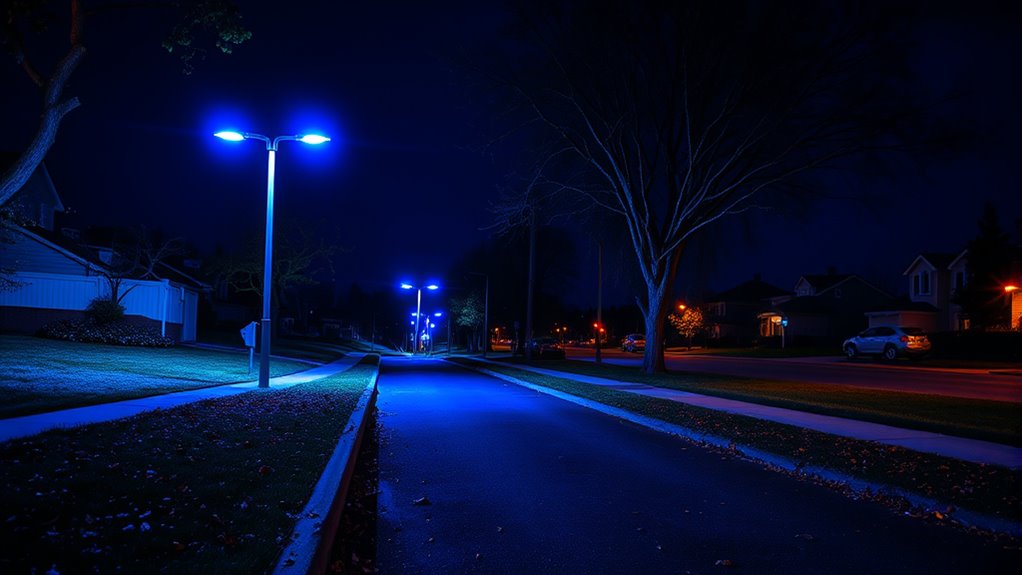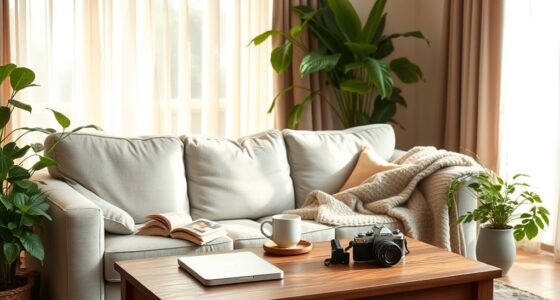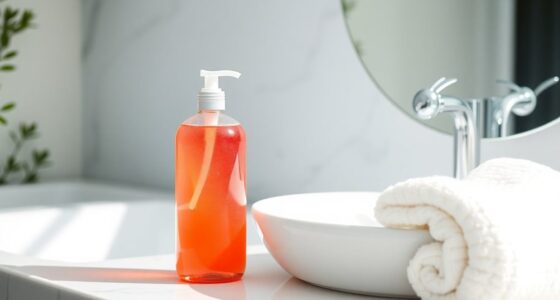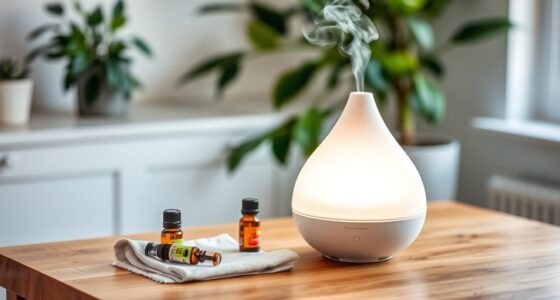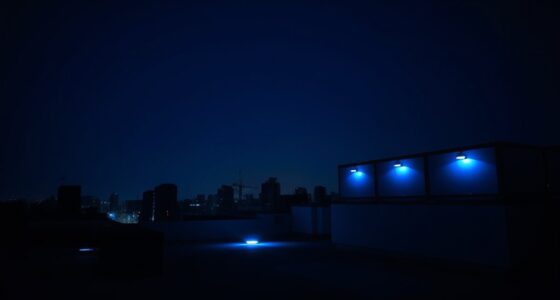Your fixtures, especially LED and fluorescent lights, emit blue light that can disrupt your sleep by suppressing melatonin. Outdoor lighting like streetlights and security lights often contribute to this, along with screens on your devices. To protect your health, consider switching to warmer, dimmer lighting and reducing screen time at night. If you want to understand how to better manage blue light in your environment, there’s more to uncover.
Key Takeaways
- Many outdoor fixtures and LED bulbs emit bluish light that can disrupt circadian rhythms at night.
- Blue light from fixtures suppresses melatonin, reducing sleepiness and affecting sleep quality.
- Modern lighting often lacks warm tones, increasing blue light exposure in indoor and outdoor environments.
- Recognizing blue light sources, like cool-toned LEDs and streetlights, helps in minimizing nighttime exposure.
- Using warm-colored lighting and limiting screen time can mitigate blue light’s negative effects at night.
Understanding Blue Light and Its Sources
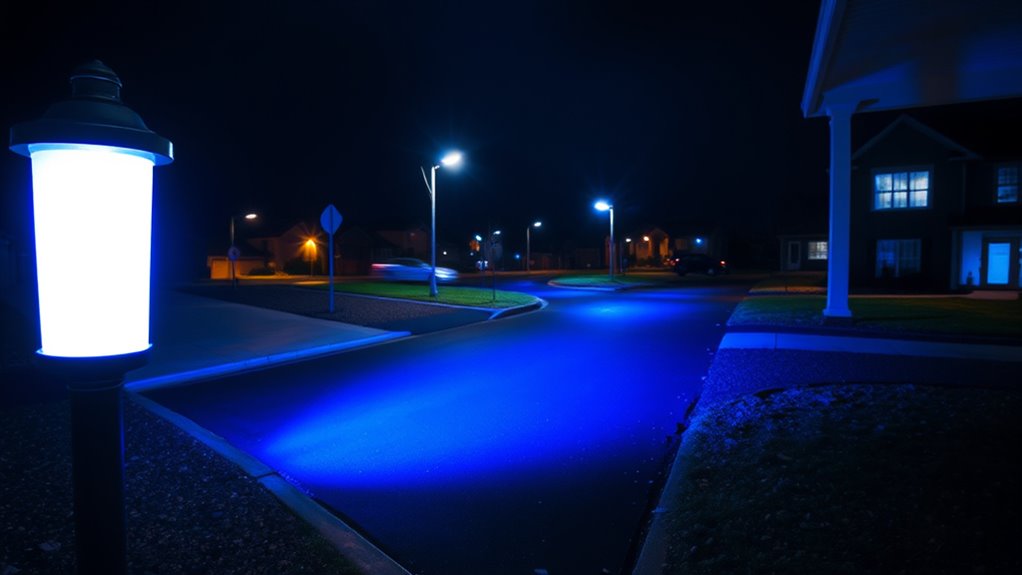
Blue light is a high-energy visible light that comes from various digital devices and natural sources. It forms part of the blue light spectrum, which ranges from about 380 to 500 nanometers. You encounter natural blue light from the sun, which helps regulate your circadian rhythms during the day. However, artificial blue sources, like smartphones, tablets, computers, and LED lighting, emit significant amounts of blue light, especially during evening hours. These artificial sources are designed to be bright and efficient but can expose you to more blue light than natural sources. Understanding where this blue light originates helps you recognize your exposure levels. Being aware of both natural and artificial blue light sources is key to managing your overall blue light exposure effectively. Additionally, the use of aesthetic lighting fixtures in home decor can influence the amount and quality of blue light in your living spaces.
How Blue Light Affects Your Sleep and Health
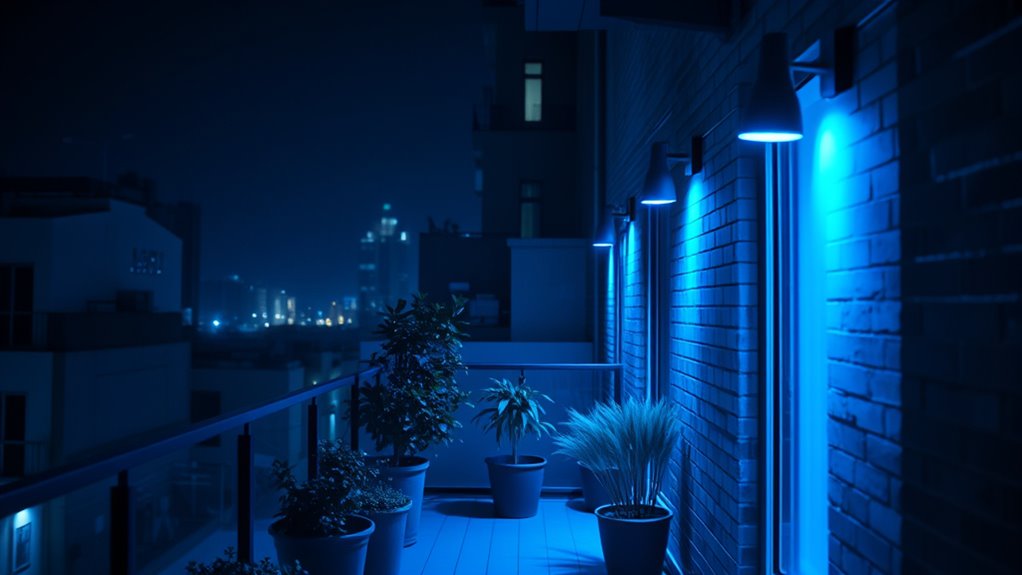
Exposure to blue light in the evening can substantially disrupt your sleep patterns and overall health. Blue light interferes with your circadian rhythm, causing circadian disruption that makes it harder to fall asleep and wake up refreshed. It also suppresses melatonin production, the hormone responsible for signaling sleep. When melatonin levels drop, you might feel more alert and less sleepy, even when it’s time to rest. Over time, this disruption can lead to poor sleep quality, fatigue, and increased stress. Chronic exposure to blue light at night has been linked to long-term health issues like weakened immune function and metabolic problems. To protect your sleep and health, it’s essential to limit blue light exposure in the evening, especially from artificial sources like screens and certain fixtures.
Common Fixtures That Emit Blue Light
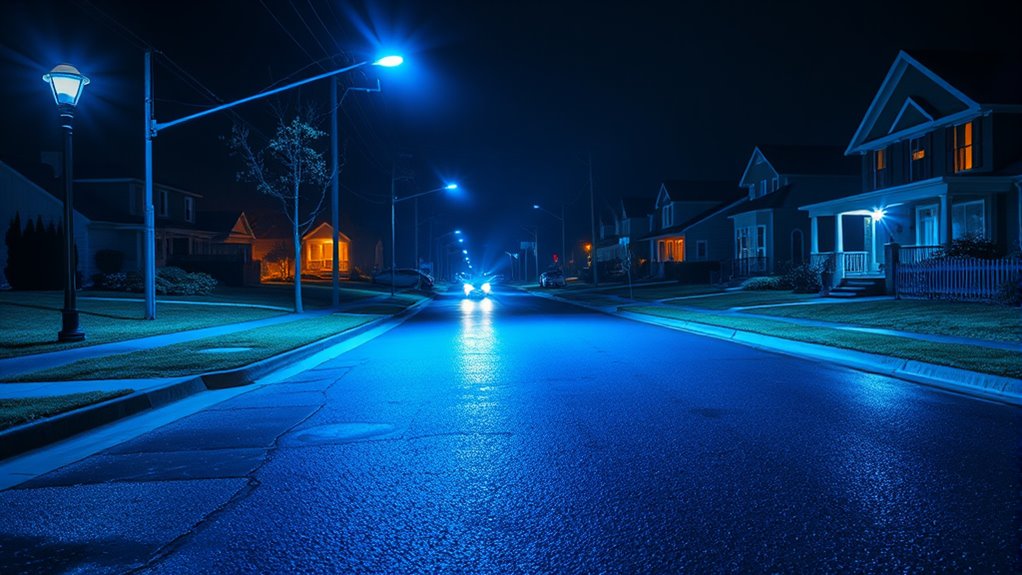
Many common household fixtures emit light that can disrupt your sleep if used in the evening. LED bulbs are one of the most prevalent sources, especially since they produce bright, bluish light similar to natural daylight. While energy-efficient, many LED bulbs lack the warm tones that minimize blue light exposure. Fluorescent fixtures are another common source, often found in kitchens, garages, and offices. They emit a bluish hue that can interfere with your melatonin production if used late at night. Even some modern fixtures labeled as “cool white” or “daylight” tend to emit significant blue light. Being aware of these fixtures allows you to make better choices, such as switching to warmer bulbs or using dimmers, to protect your sleep quality and overall health. Additionally, understanding the Victorian-inspired elements in lighting design can inspire you to select fixtures that emit softer, more ambient light, promoting better sleep.
Recognizing Blue Light Exposure in Your Environment
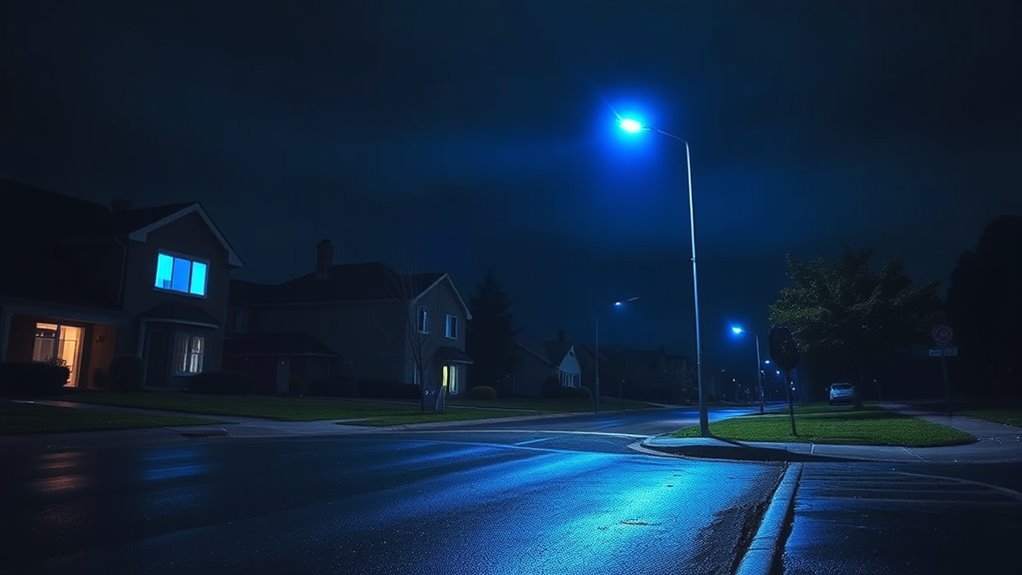
To effectively recognize blue light in your environment, it’s important to familiarize yourself with common sources and their characteristics. Blue light pollution often comes from outdoor lighting, such as streetlights, security lights, and decorative fixtures. These sources emit a bluish hue that can be difficult to notice at first but become clearer with awareness. Look for outdoor lighting that appears overly bright or has a cool, white tone—these are signs of blue light emission. Electronic devices like screens also contribute to blue light exposure, especially when used at night. By paying attention to the quality and color of your outdoor lighting and being mindful of digital screens, you can better identify blue light exposure around you. Recognizing these sources is the first step toward minimizing its impact. Additionally, understanding Gold IRA Rollovers can help you diversify your assets and protect your financial future.
Strategies to Minimize Blue Light at Night

You can reduce blue light exposure at night by switching to warm lighting in your home. Limiting your screen time before bed also helps your body wind down naturally. Small changes like these make a big difference in protecting your sleep quality. Additionally, avoiding raw food consumption close to bedtime can help prevent digestive discomfort that might interfere with rest.
Use Warm Lighting
Switching to warm lighting in your home can substantially reduce blue light exposure at night. Warm lighting features a softer, amber or yellow hue that minimizes blue light emission, helping your circadian rhythm stay in sync. When choosing fixtures, consider these tips:
- Opt for lighting with a warmer color temperature, around 2700K or lower.
- Select fixtures with designs that direct light downward, reducing unnecessary blue light dispersion.
- Use bulbs specifically labeled as “warm” or “soft white.”
- Avoid bright, cool-toned bulbs that emit higher levels of blue light.
- Incorporate Gold IRAs as part of a diversified retirement portfolio, which can be a strategic financial move.
Limit Screen Time
Reducing blue light exposure at night also involves managing screen time. By implementing screen time reduction, you limit your exposure to blue light emitted by phones, tablets, and computers before bed. Setting boundaries, like turning off devices an hour before sleep, encourages a digital detox that helps your body produce melatonin naturally. Consider establishing tech-free zones or creating a relaxing nightly routine free of screens. Using apps that filter blue light or setting device timers can make this process considerably easier. The goal is to minimize your screen time and give your eyes a break, preventing blue light from disrupting your sleep cycle. Making these small adjustments can significantly improve your sleep quality and overall well-being.
Choosing Lighting Options for Better Nighttime Wellbeing
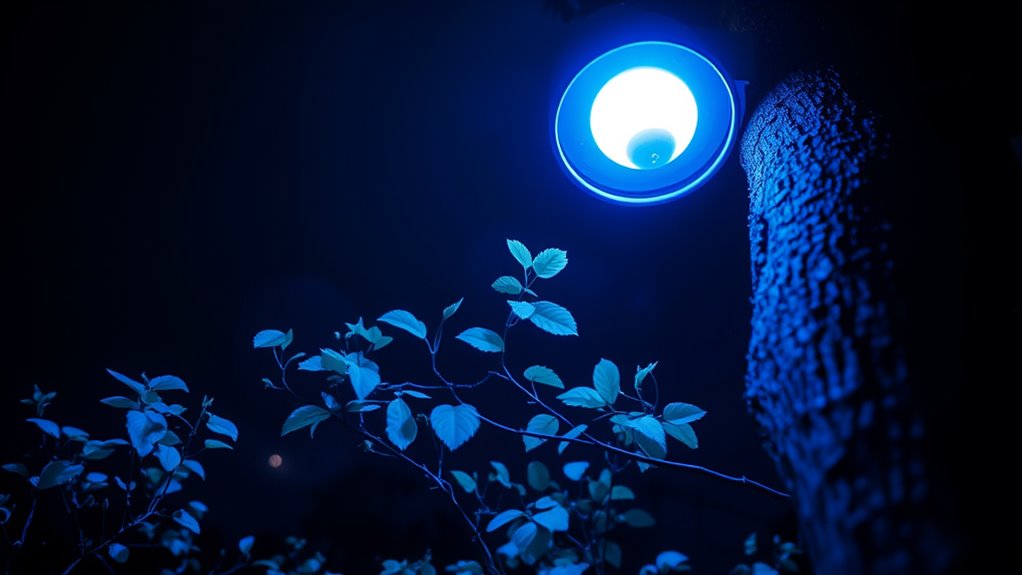
Choosing the right lighting options can substantially improve your nighttime wellbeing by minimizing exposure to blue light. Focus on lighting design that emphasizes warmer tones and dimmable fixtures to create a calming environment. Prioritize energy-efficient bulbs with low blue light emissions to reduce environmental impact. Consider these tips:
- Use warm LED bulbs with adjustable brightness
- Install dimmer switches to control light intensity
- Opt for fixtures with shielding to direct light downward
- Incorporate natural lighting sources during the day
- Be aware of lighting-related health effects and select fixtures that support better sleep hygiene.
These choices help you relax and promote melatonin production, while also supporting sustainable practices. Good lighting design not only benefits your sleep but also lessens environmental harm. By being mindful of your lighting options, you enhance your nighttime wellbeing and contribute to a healthier planet.
Frequently Asked Questions
How Does Blue Light Exposure Vary Across Different Geographic Locations?
You might notice blue light exposure varies geographically, influenced by urban lighting and rural darkness. Urban areas often have extensive artificial lighting, increasing blue light pollution, while rural regions experience less light at night, maintaining darker skies. This variation affects your exposure levels, with city dwellers facing more blue light from fixtures. So, your nighttime environment depends greatly on whether you’re in a bustling city or a quiet rural area.
What Are the Long-Term Health Impacts of Chronic Blue Light Exposure?
Imagine your nights bathed in a cold, blue glow—this chronic exposure can cause lasting harm. You risk circadian disruption, throwing your sleep cycle out of sync, and retinal damage, which may lead to vision problems over time. Long-term, this constant blue light bombardment can weaken your body’s natural rhythms, making you feel exhausted during the day and increasing your chances of health issues like depression and metabolic syndrome.
Can Blue Light Exposure Affect Children and Teenagers Differently?
You might notice that blue light exposure affects children and teenagers differently, especially with increased screen time. Their developing eyes are more sensitive, making them more prone to sleep disruption. This can lead to difficulties falling asleep and poor sleep quality, impacting their overall health and development. Limiting screen time before bed and using blue light filters can help protect young eyes and promote better sleep patterns.
Are There Specific Brands or Models Known for Low Blue Light Emission?
When it comes to blue light and fixture selection, you’re in the driver’s seat. Some brands like BenQ, Philips, and ASUS offer models specifically designed to emit low blue light, making it easier on your eyes. These fixtures help reduce eye strain and sleep disruption, so you can enjoy your screen time without worry. Choosing the right low blue light fixture is a smart move to protect your vision and well-being.
How Can I Measure the Blue Light Emitted by My Household Fixtures?
To measure blue light from your fixtures, you need a spectrometer calibrated for accurate light intensity measurement. First, verify your spectrometer has recent calibration to get precise readings. Then, point it at your light source and record the spectrum. Focus on the blue light wavelengths (around 450-495 nm). This process helps you understand the blue light emission level, enabling you to make informed decisions about your lighting choices.
Conclusion
By being mindful of the blue light around you, you hold the power to protect your nights. Imagine your home as a sanctuary, where gentle, warm illumination replaces harsh, artificial glare. When you choose your fixtures wisely, you create a haven that nurtures restful sleep and vibrant health. Let your lighting choices be a guiding beacon, illuminating your path to better well-being and peaceful nights.
